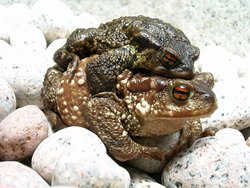Toad
The true toads are amphibians in the Bufonidae family. A number of species in other families of Amphibia are commonly referred to as toads. This is because the characteristics that are popularly used to distinguish frogs from toads are not quite the same as those used for scientific classification. more...
The type species of the family Bufonidae is the Common toad, Bufo bufo, and around it cluster a large number of species of the same genus, and some smaller genera. B. bufo is a tailless amphibian of stout build, with a warty skin, and any animal that shares these characteristics is liable to be called a toad, regardless of its location in formal taxonomy.
That the shape of the body is not a safe guide in judging of anuran groups is shown by some true frogs (Rana), which have adapted to burrowing habits, and are absolutely toad-like. The Bufonidae include terrestrial, burrowing, thoroughly aquatic and arboreal types; Rhinophrynus, of Mexico, may be described as an anteater.
Almost all toads have two lumps near the head, called the parotid glands. These glands contain poison, which oozes out if the toad is angered. Some, like cane toads, are more poisonous than others.
The genus Bufo embraces about 250 species, and is represented in nearly every part of the world except the Australian region (with the exception of the introduced Cane Toad, Bufo marinus), Madagascar, and nearly all other isolated islands.
Two species are found in the British Isles: the Common toad, Bufo bufo, and the Natterjack Toad, Bufo calamita. The former is found almost everywhere.
The Natterjack is local to England, the southwest of Scotland, and the west of Ireland. It differs from the Common Toad in having shorter limbs with nearly free toes (which are so short that the toad never hops but proceeds with a running gait) and in usually possessing orange/red warts, green eyes, and a pale yellow line along the middle of the back. It is further remarkable for the very loud croak of the males, produced by a large vocal bladder on the throat which, when inflated, is larger than the head.
The life cycle of a toad involves several stages. Typically adult toads gather in suitable pools, the first to arrive usually being the males. Their croaking may well encourage the females to arrive. A female would wish to avoid arriving at a pond which did not have any males in attendance. Gravid female toads are actively and persistently sought out by males and many males will often try to attach themselves to a single female. This can result in very large masses of toads all clinging to each other with one female at the centre. Such agglomerations of toads can be the size of a soccer ball. Eventually one male will secure solitary possession. Amplexus is the process wherein the male grasps the female while she lays her eggs. At the same time, he fertilizes them with a fluid containing sperm. The dark brown eggs are about 2.0 to 2.8 millimetres in diameter and are covered in an outer shell of gelatinous transparent aterioal which swells in contact with water. The eggs, known as toadspawn hatch into tadpoles or toadpoles. Toads lay their eggs in long strings, forming double files in straight, jelly-like tubes. The tadpole stage develops gradually into an adolescent toadlet, resembling an adult but retaining a vestigial tail. Finally the toadlet develops into an adult toad. Typically, tadpoles are herbivores, feeding mostly on algae, whereas juvenile and adult toads are carnivores.
Most temperate species of toad reproduce in the period between late autumn to early spring. In the UK most Common toad populations produce frogspawn between January and March although there is wide variation in timing. Water temperatures at this time of year are relatively low and typically between four and 10 degrees celsius. Reproducing in these conditions helps the developing tadpoles since dissolved oxygen concentrations in the water are highest at cold temperatures. More importantly, reproducing early in the season ensures that appropriate food is available to the developing toads at the right time.
Most toads eat worms, insects and a range of small invertebrates. The majority of their diet is of terrestrial origin. They hunt mostly at night.
Read more at Wikipedia.org



